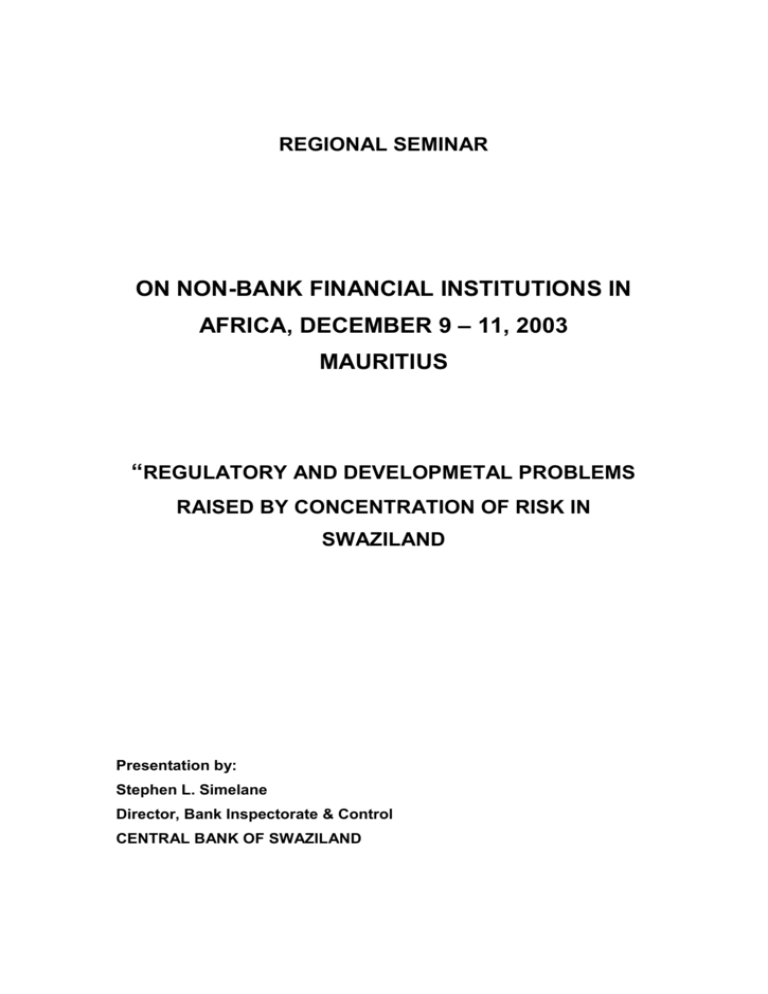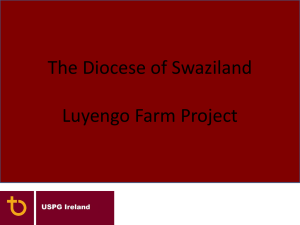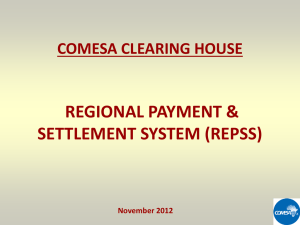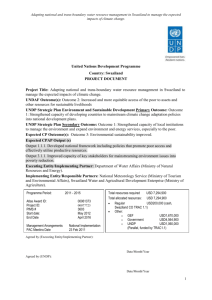Central Bank of Swaziland
advertisement

REGIONAL SEMINAR ON NON-BANK FINANCIAL INSTITUTIONS IN AFRICA, DECEMBER 9 – 11, 2003 MAURITIUS “REGULATORY AND DEVELOPMETAL PROBLEMS RAISED BY CONCENTRATION OF RISK IN SWAZILAND Presentation by: Stephen L. Simelane Director, Bank Inspectorate & Control CENTRAL BANK OF SWAZILAND Biography: Mr. Stephen L. Simelane is Director, Bank Inspectorate and Control at the Central Bank of Swaziland. Joined the Central Bank of Swaziland in 1981. After sometime in the Banking Office, in 1986 served as Assistant Manager then Manager in the Bank Supervision Division. In 1997 was appointed Director, Bank Inspectorate and Control which encompasses the Bank Supervision, Exchange Control and Development Finance Divisions. 2 Central Bank of Swaziland REGULATORY AND DEVELOPMENTAL PROBLEMS RAISED BY CONCENTRATION OF RISK IN SWAZILAND (a) A brief background on the Banking Industry in Swaziland. Introduction There are four banks operating in Swaziland, three commercial banks, one development bank and one building society. The three banks are majority owned by banks based in the Republic of South Africa. Two of the commercial banks have a minority Swazi Government participation. In addition, one sold 15 percent of its shares to the general public in Swaziland. The commercial banks are licensed in terms of the Financial Institutions (Consolidation) Order, 1975 whilst the Swaziland Development and Savings Bank was established under the terms of the Swaziland Development and Savings Bank Order (1973). Swaziland Development and Savings Bank is wholly owned by the Government of Swaziland, and its deposits are guaranteed by the Swazi Government. Housing finance needs in Swaziland are mainly provided by the building society, which is registered in terms of the Building Societies Act (1962). All the four banks are characterised by large exposures to the agriculture and forestry industry. A high concentration is on the sugar industry. Size of the Banking Industry The total assets in the banking industry were E3.4 billion in June 2003. (E1.00 is equivalent to ZAR 1.00). Total loans and advances during the same period were E2.0 billion. Total industry deposits were E2.6 billion in June 2003. Banking industry capital stood at E436.0 million in the quarter ended June 2003. Loans and advances of the banking system classified by type reflected an annual growth of 52.5 percent on agriculture and forestry to E357.2 million as at December 2002 compared to 23.6 percent recorded the previous year. The manufacturing sector recorded a growth of 7.8 percent to E297 million against a decline of 26.7 percent observed the previous year (2001). Risk Concentration To guide the management of the concentration risk, the Central Bank of Swaziland issued “The Lending Limit, Aggregation and Attribution Regulations, 2001”. The provisions of this regulation are stated below: A financial institution shall not, directly or indirectly grant to a person or permit to be outstanding any loan, give any financial guarantee; or incur any other liability on behalf of that person, such that when aggregated, the total value of such loans, financial guarantees or other liabilities on behalf of that person is at anytime more than twenty-five percent (25%) of the unimpaired paid up or assigned capital and unimpaired balance in the reserve account of such financial institution. A financial institution shall not permit the aggregate of large credit exposures outstanding at any one time to exceed eight hundred percent (800%) of the unimpaired paid up or assigned capital and unimpaired balance in the reserve account of such financial institution. These Regulations, although in operation will be enforceable after amendments to the Financial Institutions Order have been promulgated. (b) The size of the Royal Swaziland Sugar Corporation and Swaziland Sugar Association both in terms of its dominance of the Stock Exchange and of banking lending. Total borrowing by the Swaziland Sugar Association stood at E883.0 million as at 30 June 2003. This would translate to 43.5 % as a percentage of banks’ lending to the private sector, which is also 281.1% of combined capital of the banks. The distribution of the total exposure to the Swaziland Sugar Industry per individual bank is as follows: 2 BANK A. ACCOUNT A Lending as a percentage of total loans Lending as a percentage of capital ACCOUNT B Lending as a percentage of total loans Lending as a percentage of capital BANK B. E100 Million 38.06% 337.9% E30 Million 11.4% 101.4% E300 Million Lending as a percentage of total loans Lending as a percentage of capital 44.6% 805.3% BANK C. ACCOUNT A Lending as a percentage of total loans Lending as a percentage of capital ACCOUNT B Lending as a percentage of total loans Lending as a percentage of capital E200 Million 22.3% 460.3% E253Million 28.2% 582.3% Dominance of Stock Exchange The Royal Swaziland Sugar Corporation (RSSC) was listed in the Swaziland Stock Exchange (SSX), in September 1992. It was the biggest counter at that time accounting for 77.0 percent of total market capitalization. Currently, the counter accounts for 84.0 percent of total market capitalization. This tends to affect the performance of the exchange as measured by the All Share Index since the counter dominates the index. Swaziland Sugar Association issued a bond in the market and it matured in August 2003. The nominal value was E12.5 million. 3 (c) A review of the problems faced in meeting the Basle requirements. The dominance of the RSSC in the Swaziland corporate sector creates a paradox for the banks in that it places the needs of the country and indeed their own profitability in direct conflict with one of the most basic risk management principles, that of diversification. One of the most important services provided by financial intermediaries is the professional management of credit, market, liquidity and other risks. Such risks must not be allowed to lead to instabilities in the financial sector. To reinforce this principle, over and above the institution’s own risk provisioning measures, specific prudential rules were laid down for financial institutions, primary among which are the capital adequacy requirements. A risk-adequate capital cushion, though very important, cannot on its own guarantee the solvency of a bank and the stability of the banking system. The crucial factor ultimately is the bank’s risk/return profile determined by its managers coupled with its ability to control and sustain the risks entered into. Large exposure limits are designed to ensure that the risk/return profile stays within acceptable bounds. At the end of July 2003, total Capital and Reserves for all banks in Swaziland stood at E110 million. Of the large lines of credit approved by the Central Bank from January 2003 to 31 July 2003, a total of E883 million was approved for the sugar industry. This translates to 803% of the combined bank capital and reserves. On the other side of the balance sheet, the Swaziland sugar industry has changed substantially. It is now very dependent on internal efficiencies to ensure international competitiveness in a highly sophisticated market place. Its survival depends largely on access to credit. This creates a major problem in the ability of the local financial market to satisfy the appetite of the sugar industry. Meeting the financing needs of the sugar industry is equally important to the banks. In Swaziland, there are limited options of bankable corporate deals, and that is largely attributable to the not so dynamic market. The downsizing of local commercial bank’s loans to within 25 percent of their total capital and reserves, as per the requirements of The Lending Limit, Aggregation and 4 Attribution Regulations, 2001, would impair the investment viability of the banks. For local banks to satisfy the borrowing appetite of the sugar industry and the large exposure limits implies either a massive (and uneconomic) increase in bank capital, or an alternative solution that mitigates risk without requiring additional capital. (d) Solutions being pursued to meet Basle Requirements vis-à-vis Capitalization. Risk Participation The Lending Limit, Aggregation and Attribution Regulations, 2001 allows for banks that would want to lend in excess of their capital to utilize loan participation agreements with other banks. One of the local banks has opted to enter into a Risk Participation Agreements with its parent bank in South Africa to mitigate credit risk. This agreement allows for the local bank to lend more than the 25 percent of their total capital and reserves, with the excess funds coming from the major shareholder. The pledged funds are held either in the local subsidiary or the South African bank. This arrangement is designed to allow the local bank access to the funds, should the need arise to call them up. The involvement of the parent bank is two fold. One, to afford the local borrower access to funds and two, to participate in the credit risk involved in the whole transaction. Provisioning Requirement Inspection Circular No. 8, requires all banks in Swaziland to hold in their books, an amount equivalent to one percent of their total loan book as general provisions. Specific provisions are then raised by the bank in accordance with the quality of the afforded loans. In view of the risk participation agreement to cover large exposures, the bank that has chosen this solution regards the 1 (one) percent provision requirement as punitive. At the same time, without some other form of risk mitigation, the provisioning requirement by itself is unlikely to be sufficient in the event of a serious deterioration in the credit standing 5 Guarantees and Credit Derivatives In Swaziland, banks are also allowed to use guarantees as an additional cover against credit risk on large lending in excess of 25 percent of their capital and reserves, but for these to be recognized and be relied upon, they must be in writing, affirmed, irrevocable, unconditional and must be issued by a non-affiliated financial institution. This would, mean that, parental guarantees are not acceptable and/or relied upon, as they are from an affiliated financial institution. Basle II, although not yet implemented in Swaziland, not only allows the use of guarantees in the credit risk mitigation techniques, but also contemplates the use of credit derivatives. Credit derivatives are swap, forward and option contracts that transfer risk and return from one counterparty to another without actually transferring the ownership of the underlying assets. Credit derivatives are an ideal tool for lenders who want to reduce their exposure to a particular borrower but find themselves unwilling (say, for tax-or cost-related reasons) to sell outright their claims on that borrower. Default swaps transfer the potential loss on a “reference asset” that can result from specific credit “events” such as default, bankruptcy, insolvency, and credit-rating downgrades. (e) Issues raised by each approach and how Swaziland has dealt with them. In Swaziland, as indicated earlier, the three commercial banks are subsidiaries of South African banks while the Development bank is owned by Government. In a bid to raise awareness to banks about the Basel II New Capital Accord, the Central Bank of Swaziland in June 2003, distributed the New Capital Accord booklets to all the banks. Preparations for the implementation of the New Capital Accord have not been started. On the other hand, the Central Bank is closely following progress made by the South African Reserve Bank, as a home country supervisor of the subsidiaries of South African Banks represented in Swaziland. 6 The guarantee solution One of the banks has approached the Central Bank of Swaziland to discuss how a guarantee might be structured so as to satisfy the requirements. These discussions are continuing but, as yet, the bank has not resolved a structure that is likely to meet the requirements of Basel II. The credit derivative solution Another option for the local banks is to reduce their asset levels in excess of 25 percent of their capital by cession and assigning those excess facilities to their parent banks. This, however, has its disadvantages as it impacts negatively on the profitability of the subsidiary in that interest earnings are reduced. The latest option acceptable to the Central Bank for purposes of mitigating credit risk exposure is the use of credit derivatives, credit default swaps in particular, to cover the large risk exposures with the Swaziland banks. This is of particular importance in that the credit exposure is in relation to the production and marketing of sugar, a readily marketable commodity. One of the banks has chosen this option. Concluding Thoughts In conclusion, it is a challenge to the Central Bank, as a regulatory authority, to enforce compliance to international standards or best practice in an environment where the borrowing needs of one major industry, which is a back bone of the country’s economy cannot be satisfied by the lending capacity of the total banking industry. While this problem has arisen in banking, it is just as possible that a concentration risk like this could arise in insurance or other area of non-bank finance. The challenge in each case is to find a solution that mitigates the risk that arises from the large concentration, without undermining the basic financial viability of the institutions involved. 7








